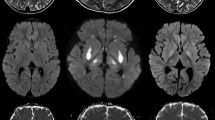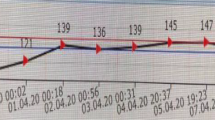Abstract
A 54-year-old Japanese man entered our hospital for investigation of appetite loss. His blood pressure was 201/113 mmHg, and laboratory findings revealed renal failure and hyponatremia. On physical examination, disorientation and dysarthria were observed. Hemodialysis was performed the same day. Magnetic resonance imaging (MRI) after hemodialysis revealed swelling of the brainstem and a high signal intensity on fluid-attenuated inversion recovery (FLAIR) imaging, similar to findings of central pontine myelinolysis (CPM), which is generally irreversible. However, on an apparent diffusion coefficient (ADC) map based on diffusion-weighted MRI, higher signal intensity was observed in the area of the high signal intensity on FLAIR imaging, which is not seen in CPM. The abnormal neurological symptoms improved within a few days, and MRI findings also normalized. We diagnosed the lesion as the brainstem variant of reversible posterior leukoencephalopathy syndrome (RPLS) with uremia. ADC map was very useful in diagnosing RPLS with uremia.

Similar content being viewed by others
References
Hinchey J, Chaves C, Appignani B, Breen J, Pao L, Wang A, et al. A reversible posterior leukoencephalopathy syndrome. N Engl J Med. 1996;334:494–500.
Utsumi K, Amemiya S, Iizuka M, Iino Y, Katayama Y. Acute posterior leukoencephalopathy in a patient with nephrotic syndrome. Clin Exp Nephrol. 2003;7:63–6.
Chang GY, Keane JR. Hypertensive brainstem encephalopathy: three cases presenting with severe brainstem edema. Neurology. 1999;53:652–4.
Nagata M, Maeda M, Tsukahara H, Maier SE, Takeda K. Brain stem hypertensive encephalopathy evaluated by line scan diffusion-weighted imaging. AJNR Am J Neuroradiol. 2004;25:803–6.
Cramer SC, Stegbauer KC, Schneider A, Mukai J, Maravilla KR. Decreased diffusion in central pontine myelinolysis. AJNR Am J Neuroradiol. 2001;22:1476–9.
Bartynski WS. Posterior reversible encephalopathy syndrome, part 1: fundamental imaging and clinical features. AJNR Am J Neuroradiol. 2008;29:1036–42.
Bartynski WS. Posterior reversible encephalopathy syndrome, part 2: controversies surrounding pathophysiology of vasogenic edema. AJNR Am J Neuroradiol. 2008;29:1043–9.
Schwartz RB, Mulkern RV, Gudbjartsson H, Jolesz F. Diffusion-weighted MR imaging in hypertensive encephalopathy: clues to pathogenesis. AJNR Am J Neuroradiol. 1998;19:859–62.
Kitaguchi H, Tomimoto H, Miki Y, Yamamoto A, Terada K, Satoi H, et al. A brainstem variant of reversible posterior leukoencephalopathy syndrome. Neuroradiology. 2005;47:652–6.
Chen CL, Lai PH, Chou KJ, Lee PT, Chung HM, Fang HC. A preliminary report of brain edema in patients with uremia at first hemodialysis: evaluation by diffusion-weighted MR imaging. AJNR Am J Neuroradiol. 2007;28:68–71.
Yoon CH, Seok JI, Lee DK, An GS. Bilateral basal ganglia and unilateral cortical involvement in a diabetic uremic patient. Clin Neurol Neurosurg. 2009;111:477–9.
Soupart A, Penninckx R, Stenuit A, Decaux G. Azotemia (48 h) decreases the risk of brain damage in rats after correction of chronic hyponatremia. Brain Res. 2000;852:167–72.
Acknowledgments
We are indebted to Mr. J. S. Gelblum (Kanazawa Gakuin University) for his critical reading of this manuscript.
Author information
Authors and Affiliations
Corresponding author
About this article
Cite this article
Katano, K., Kakuchi, Y., Nakashima, A. et al. Apparent diffusion coefficient map based on diffusion-weighted magnetic resonance imaging is useful in diagnosing the brainstem variant of reversible posterior leukoencephalopathy syndrome with uremia. Clin Exp Nephrol 14, 479–482 (2010). https://doi.org/10.1007/s10157-010-0293-0
Received:
Accepted:
Published:
Issue Date:
DOI: https://doi.org/10.1007/s10157-010-0293-0




